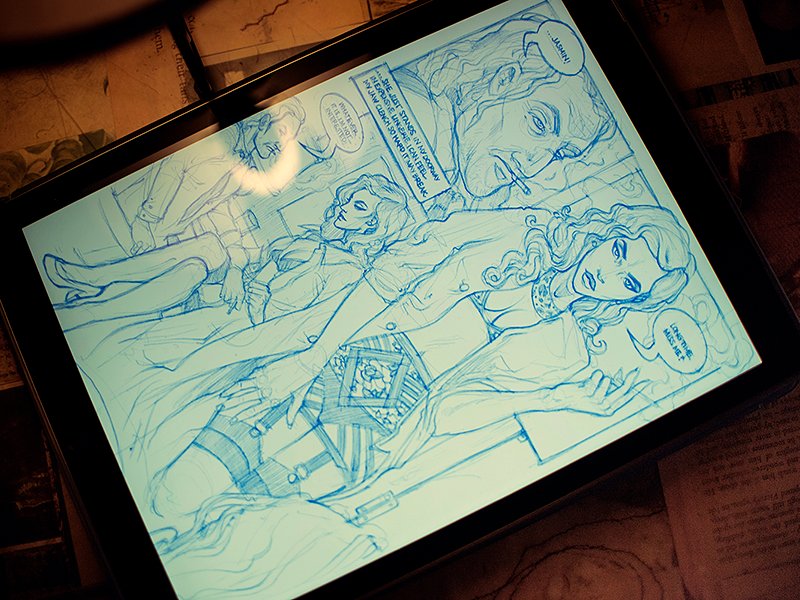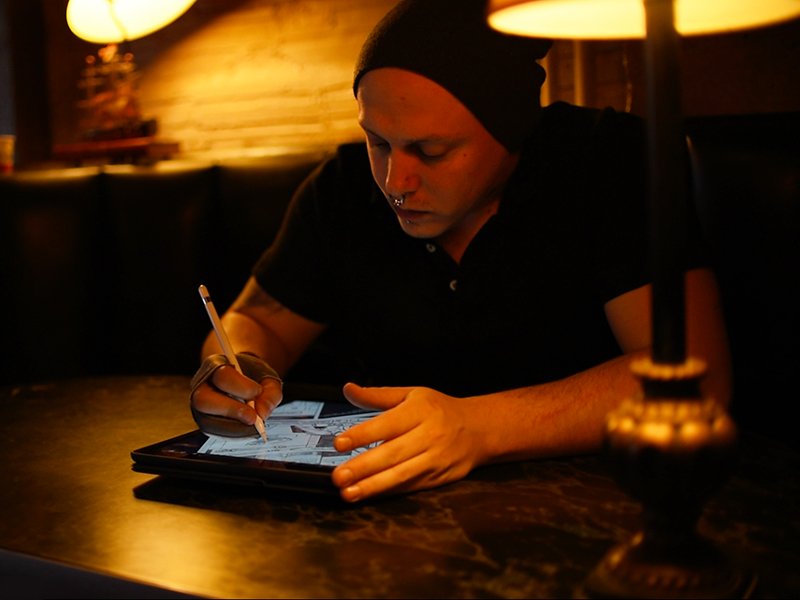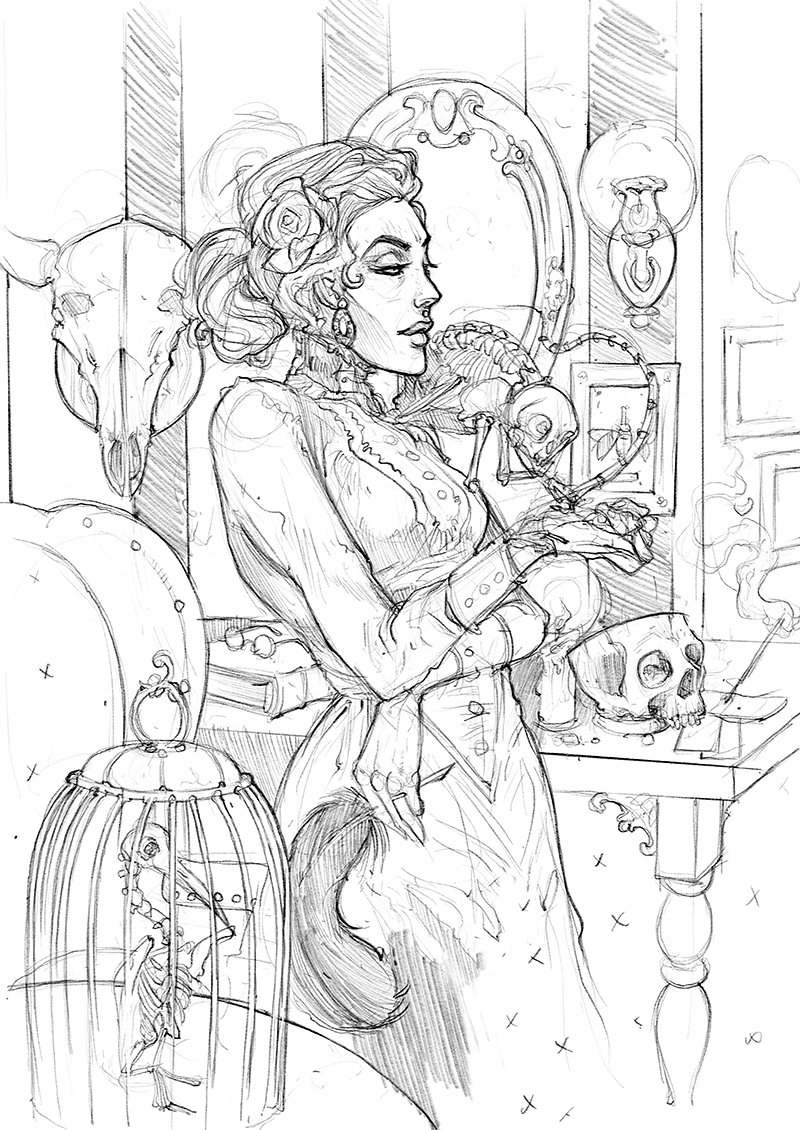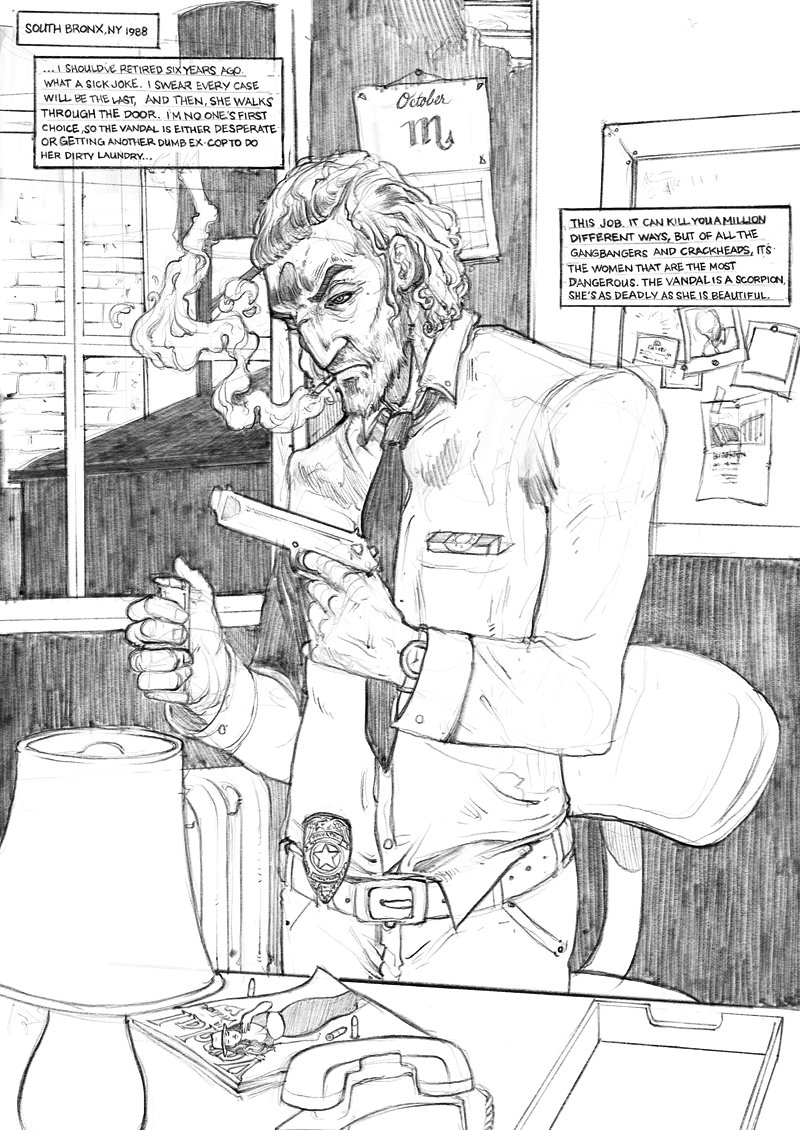
I’m not a tech blogger. I am, however, a technology enthusiast, and an artist. Minneapolis is an art city, and as such, many in my circle are artists. Of the artists, many are tree pulp, raw materials purists, but I am not. I am and always have been an illustrator. I was never seduced by the smell of turpenoid or the “feel of paper”. […I swear to Christ if I hear one more hipster say that!]
Long before there was an iPad, there were very shitty laptop solutions that opened, and twisted around, giving a glass surface for pen input. Those first iterations were bad, but as a proof of concept, I lusted for the days I could start leaving sketchbooks and pencil boxes at home, drawing digitally at the level I could traditionally.
Around 2007, I earned a decent payday from a cartoon studio I was working at as a subcontractor. With that, I ordered my first Wacom Cintiq! It arrived and I salivated white cutting in to the box. After arduous testing, I simply boxed and taped it back up and shipped it back to Wacom well within the return window. I’m sorry. I hated it!
The Cintiq was a lot of money back then […I think they still are a second mortgage], and for that amount of money, it didn’t come close for my needs! I know, it’s an industry standard, and I have friends in the art work that learned on this platform and have developed such muscle memory they couldn’t leave that comfort zone of that device [even if it is inferior].
Here’s where I vent on Wacom and explain a $2000 purchase, and subsequent return. They are, without a doubt, the standard for digital artists. As much as that’s a fact, I feel it’s a big part of the problem. The biggest decisions of my return were latency, air gap between the glass, and portability. My experience with where their technologies were in 2007, haven’t improved noticeably in a decade, in those categories. Last fall, my friend Micheline bought a Cintiq Companion, and all the same deal breakers for me were still present.
In October of last year, Apple announced the 12.9” iPad Pro, and I feverishly began scraping together $1000 for it’s launch the following month. This device was rumored for almost two years, and I fantasized about it solving every issue I had with the Cintiq. Moreover, I was in the throes of an explosive photography career requiring tens of thousands of miles of travel every few weeks, from LA to NY, and back, all the while still living in Minneapolis. A true artists tool, thin and portable, comparable to sketching on paper seemed too good to be true, but it didn’t stop me from obsessing over it. I daydreamed of flights so long I could finish entire drawings.

Smash cut to now, I’ve been the proud owner of a 12.9” 128GB WiFi/Cellular Space Grey iPad Pro for six months. How has it affected my life? Enough to passionately write a review on Steemit, caring not what revenue I even make. It has been nothing short of life changing for me. My praise could go through every corner of the device, but keep in mind, this particular column is focused on how it has impacted me as an artist.
Technical specifications have been out a while now, but for those that aren’t familiar with what the 12.9” iPad Pro brings to the table, here it is.
12.9‑inch iPad Pro
Wi-Fi models
1.57 pounds (713 grams)
Wi-Fi + Cellular models
1.59 pounds (723 grams)
Retina display
12.9-inch (diagonal) LED-backlit Multi-Touch display
2732-by-2048 resolution at 264 pixels per inch (ppi)
Fingerprint-resistant oleophobic coating
Fully laminated display
Antireflective coating
A9X chip with 64‑bit architecture
M9 coprocessor
1080p HD video recording at 30 fps
Slo-mo video support for 720p at 120 fps
Time-lapse video with stabilization
Video image stabilization
Built‐in 38.5‐watt‐hour rechargeable lithium‐polymer battery with up to 10 hours of battery life.
Touch ID
Apple Pay
Siri
The experience can’t be quantified by specs, though. Microsoft’s Surface and Surface Book, along with some phones use N Trig technology. Wacom has their own proprietary standard boasting 2048 points of pressure sensitivity. Apple, true to the company’s DNA, controls the hardware and software of the iPad Pro, bringing a completely re-engineered technology to stylus input utilizing it, and the digitizer in harmony.
The experience sketching and inking is unmatched, and you can believe that prior to my iPad Pro purchase, I tried them all. It is so rare to have your expectations of a product exceeded like mine were here […and rest assured, my expectations were very high after two years of rumor sniffing]. Here’s a look at a sketch I recently did of a necromancer for a 1800’s Southwestern ghost story I’m working on, and a hyper lapse of the procress.

Excluding the incredible Pencil capabilities, I find myself using many of the features of iOS 9, but most frequently, split view. On the 12.9” iPad Pro, split view is like having two full sized 9.7” iPads next to one another, and I use it for reference by doing a simple Google Image search, or working directly from my script in Final Draft for iOS.
Until recently, there were some limitations keeping the iPad Pro from reaching it’s professional potential. Previously, canvases in Procreate […the premiere painting and drawing app on iOS by Savage Interactive] only allowed for 72dpi projects. With recent updates to iOS and Procreate 3.0, you can now work in 300dpi 4K canvases in brilliant retina fashion. Again, all while bringing your ideas to life with no latency, and a point that literally touches a single pixel.

Now, I don’t want to make it seem like Wacom or Surface loyalists are wrong if they prefer either solutions. Really, with something like this, it comes down to what you’re used to. Many people have an aversion to Apple for a variety of reasons. The argument made that “…it’s just not serious for finished work”, and “…it doesn’t run a real OS or professional software” are no longer legitimate attacks on the iPad Pro regarding professional level art. In addition to the high res canvases, Adobe has begun allowing users to import and edit RAW images in it’s Photoshop and Lightroom apps. Lastly, Astropad brings a true Cintiq style experience to the iPad Pro, acting as a display for any computer running full Photoshop, Illustrator, ZBrush or any other desktop application to the iPad Pro.
To illustrate that point, I’ll leave you with this time lapse video of James Jean finishing a piece exclusively for Juxtapoz magazine, done entirely on the iPad Pro using Apple Pencil and Procreate.
More of my art can be found by following me on Instagram @Kommienezuspadt, SnapChat @madeineighty. I have a Patreon campaign for my comic THEIA at www.theiacomic.com and naturally, most of my newer work will be shared here on Steemit first.
Thanks for reading!
